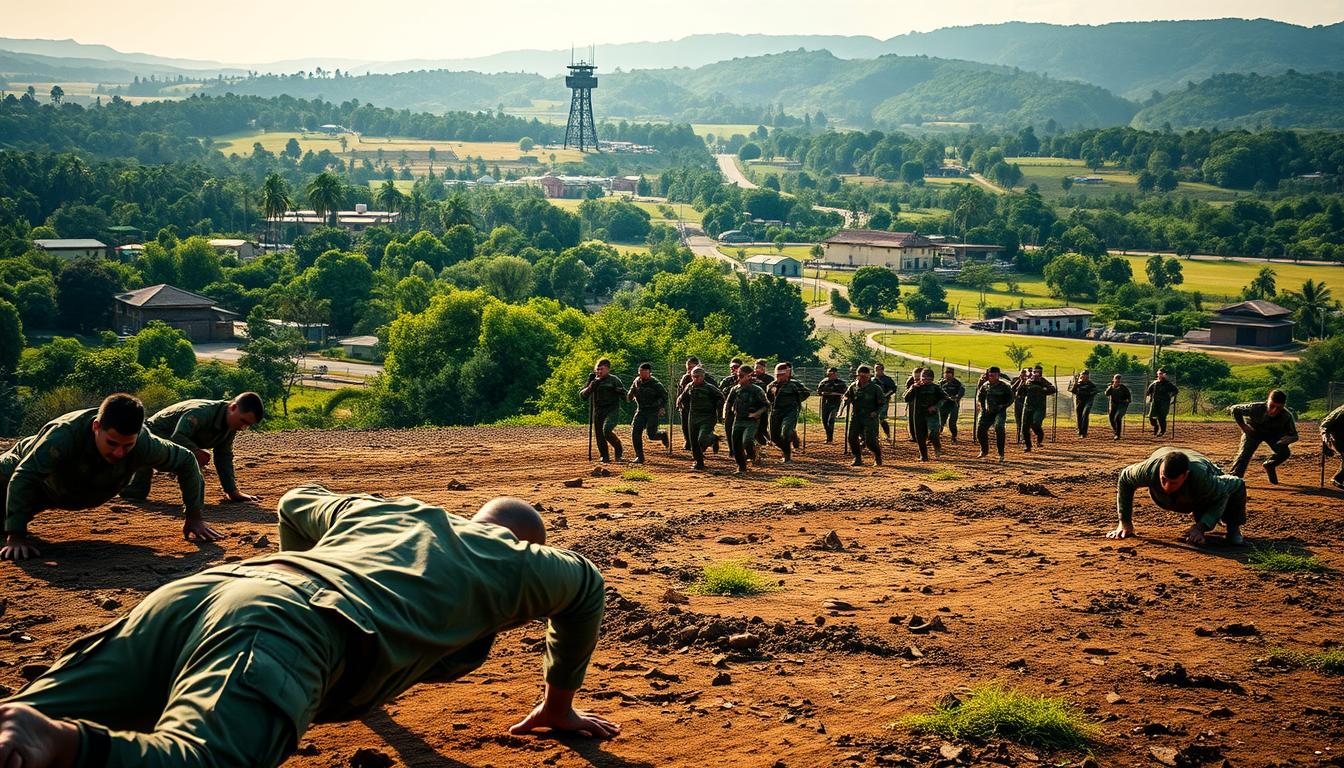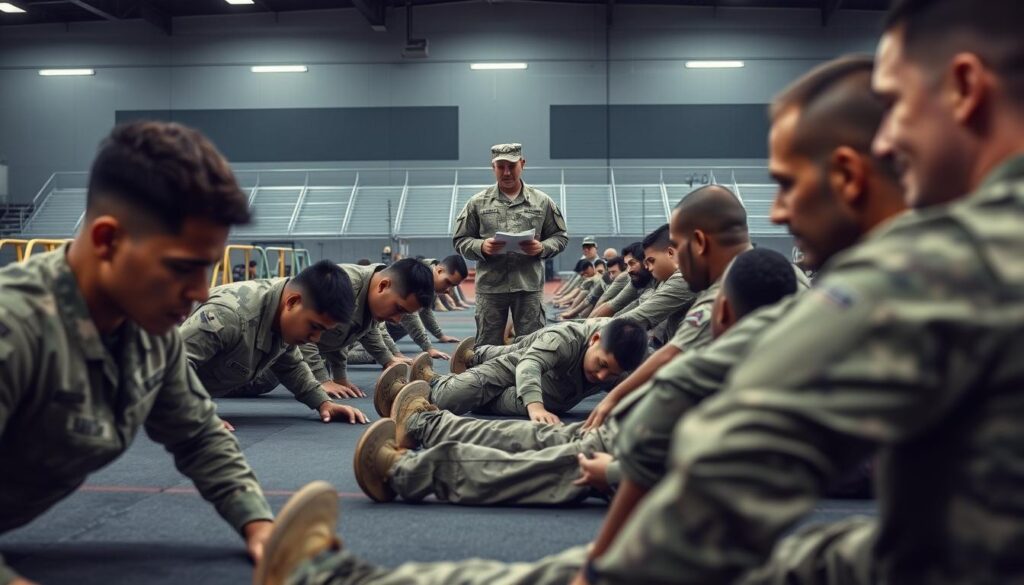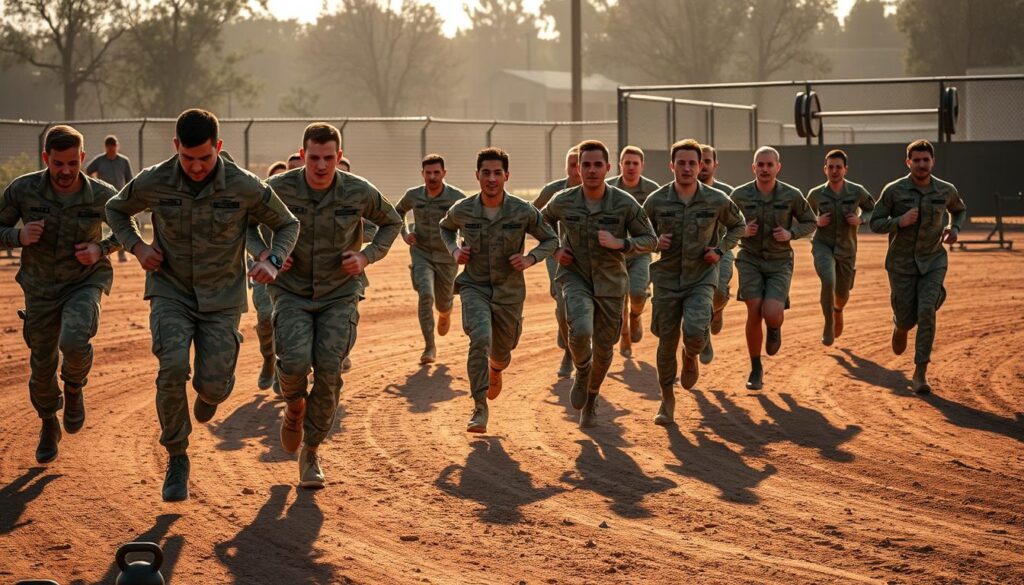Are you getting ready to join the military but unsure about the fitness needs? Many people have wrong ideas about what it takes to be fit for military service.
Stew Smith, a former Navy SEAL, says common myths surround Army fitness. It’s key to know the difference between what’s true and what’s not. As you get ready for military life, knowing the truth can help you focus your training effectively.
This article aims to clear up some of the most common Army fitness myths. It will give you a better understanding of what to expect and how to prepare.
Key Takeaways
- Understanding the truth behind common Army fitness myths
- Insights from a former Navy SEAL on effective training
- Preparation tips for meeting Army fitness standards
- Debunking prevalent misconceptions about military fitness
- Effective training strategies for military service
Myth1: You Need to Be in Perfect Shape to Join the Army
Many think they must be super fit to join the Army. This stops some from enlisting, feeling they’re not good enough. But, the Army has clear fitness standards, not a need to be perfect.
Overcoming Common Misconceptions
Some believe joining the Army means being very athletic. This is not entirely accurate. The Army trains recruits to meet fitness standards. These include endurance, strength, and agility tests.
The Army’s fitness tests check if soldiers can do their jobs well. These tests include:
- Push-ups: Assessing upper body strength
- Sit-ups: Evaluating core strength and endurance
- 2-mile run: Testing cardiovascular endurance
The Truth About Fitness Standards
The Army’s fitness test shows if a soldier can do their job. It’s not about being a pro athlete. It’s about having enough fitness to do military tasks. The standards are clear for all soldiers.
Here’s a look at the minimum scores needed for different ages in the Army Physical Fitness Test (APFT):
| Age Group | Push-ups (2 minutes) | Sit-ups (2 minutes) | 2-mile Run |
|---|---|---|---|
| 17-21 | 42 | 53 | 13:00 minutes |
| 22-26 | 40 | 52 | 13:12 minutes |
| 27-31 | 38 | 50 | 13:24 minutes |
Preparation is key. You don’t need to be perfect, but some fitness helps. Focus on cardio, strength, and flexibility to prepare.
Myth2: All Army Workouts are Intense and Extreme
Many think Army training is always tough and extreme. But, Army fitness plans vary to meet different needs and goals. They make sure soldiers are ready for their jobs.
Varied Training Programs
The Army has many training programs. These include endurance training, strength training, and agility training. A typical day might start with a run, then strength exercises, and end with agility drills. This mix keeps training interesting and stops plateaus.
Army fitness plans mix cardio, strength, and flexibility exercises. A fitness expert says, “A good plan changes intensity and volume to avoid burnout and overtraining.”
“The key to a successful Army workout is not just about being intense; it’s about being consistent and varied.”
Balancing Intensity with Safety
Army training is intense, but safety comes first. Programs slowly increase intensity to help soldiers adapt and avoid injuries. New recruits start with basic training to build a strong foundation before moving to harder training.
Important military fitness tips include:
- Always warm up to prevent injuries.
- Do a mix of cardio and strength exercises.
- Make sure to rest to avoid overtraining.
Here’s what a balanced Army workout might look like:
| Day | Cardiovascular Training | Strength Training | Agility Training |
|---|---|---|---|
| Monday | 30 minutes run | Upper body strength training | Agility drills |
| Wednesday | Cycling | Lower body strength training | Obstacle course training |
| Friday | Swimming | Core strength training | Team sports for agility |
A balanced fitness approach is crucial in Army training. It ensures soldiers are fit, safe, and ready for their duties.
Myth3: Strength Training is More Important than Cardio
Many think strength training is key for military fitness, ignoring the need for cardio. But, both are vital for top military fitness.
Cardio is key for endurance and stamina. It lets soldiers do their jobs well for a long time. Running, swimming, and cycling boost heart health and stamina, helping soldiers stay strong.
The Role of Cardiovascular Health
Cardio fitness is crucial for soldiers. It helps them do tasks that need lots of energy over time. Long marches and combat operations need strong hearts.
A strong heart helps in recovery. Soldiers can get back to action faster after hard workouts.
Integrating Both for Optimal Fitness
Good fitness for soldiers mixes strength training and cardio. Strength training builds muscle and power. Cardio boosts endurance and stamina.
A good plan might include weight training, bodyweight exercises, and cardio. For example, a soldier might do strength training on Monday and Thursday. Then, cardio on Tuesday and Friday.
“The first time you jump out of a perfectly good airplane, you’re not going to be thinking about the other guy.”
This shows how important being ready and fit is.
By mixing strength and cardio, soldiers get very fit. This improves their performance and lowers injury risk.
Myth4: Soldiers Never Get Injured
Soldiers do get injured, despite what many think. The hard work and risks of military life make them prone to injuries. These can range from minor to serious.
Understanding Military Injury Rates
Many soldiers get hurt during their time in the military. Studies show their injury rates are similar to or even higher than professional athletes. This is a big concern for military leaders.
The most common injuries are muscle and bone problems, stress fractures, and overuse injuries. Here’s a look at injury rates in different branches:
| Military Branch | Injury Rate per 1,000 Personnel |
|---|---|
| Army | 240 |
| Navy | 180 |
| Air Force | 150 |
| Marine Corps | 260 |
Injury Prevention Strategies
Knowing about injuries helps in preventing them. Injury prevention involves good training, the right gear, and recovery plans.
A fitness expert says, “Preventing injuries is as important as training for performance. It needs a complete plan for soldiers’ health.”
“The key to preventing injuries is to balance intensity with recovery, ensuring that soldiers are not pushed beyond their limits without adequate rest and rehabilitation.”
Good strategies include:
- Gradual increase in training intensity
- Proper warm-up and cool-down exercises
- Strengthening core and stabilizer muscles
- Using the right gear and equipment
By using these methods, military groups can lower injury rates. This boosts performance and helps soldiers stay healthy.
Real military fitness insights show it’s key to debunk the myth of soldiers never getting hurt. By facing the truth about injuries, we can make training safer and more effective.
Myth5: You Can’t Exercise During Basic Training
Many think they won’t exercise during basic training. But, the truth is, exercise is a big part of it. The Army’s training pushes recruits hard, and working out is key to that.
Physical Training Activities
Basic training includes running, strength exercises, and obstacle courses. These help improve fitness and get recruits ready for military life. Knowing what’s coming helps them prepare better.
Preparing for Basic Training
To get ready for basic training, start with a fitness plan. Include cardio, strength training, and flexibility exercises. Using army fitness tips in your routine can boost fitness and lower injury risk. Following military fitness tips helps stay focused and reach fitness goals.



